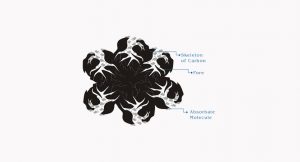 Feb 1,2020
Feb 1,2020

The FAO has estimated that worldwide about 25% of crops are affected annually with mycotoxins (Jelinek et al 1989). It is generally accepted that Aspergillus, Fusarium and Penicillium molds are amongst the most important in producing mycotoxins detrimental to animals (CAST, 2003). The mycotoxins of greatest concern include: aflatoxin produced by Aspergillus; deoxynivalenol; zearalenone, T2 toxin and fumonisin produced by Fusarium, and ochratoxin and PR toxin produced by Penicillium.
Mycotoxins can reduce animal performance and health because of toxic effects that can impact most of the bodily systems(CAST, 2003). Effects are dependent on specific mycotoxins, the amount, the duration of exposure and animal factors such as age, sex and level of stress. Under practical conditions, no animal feed is completely free of mycotoxins. Additionally, no feed can be expected to contain only one mycotoxin.
Considerable research has been directed at finding methods to prevent toxicity of mycotoxins. Some of the approaches have included mycotoxin separation from contaminated feeds, detoxification and inactivation. Detoxification and inactivation methods include use of bindersor sequestering agents added to feed as an approach to reduce toxicity of mycotoxins by reducing reactivity of bound mycotoxins and reducing their intestinal absorption. Substances used as mycotoxins binders include indigestible adsorbent materials such as silicates, activated carbons, complex carbohydrates and others.
A binder must be effective at sequestering the mycotoxins of interest. In some cases, it may be of value to bind one specific mycotoxin and in others, to bind multiple mycotoxins. A binder should significantly prevent animal from toxicity. Cost should render its use practical and profitable. There should be no detrimental effects on the animal food product. The binder should be physically usable in commercial feed manufacturing. Binder’s use and efficacy should be verifiable. Considering these attributes, Activated carbon emerges as a binder of choice of feed manufacturers.
Activated carbon has been used to adsorb toxins since the dawn of civilisation. The Egyptians used it as a topical antidote to poisoning and ancient Hindus filtered their water with it.
Activated carbon is a carbonaceous, highly porous adsorptive medium that has a complex structure composed of carbon atoms. The network of pores in activated carbons are channels created within a rigidSkelton of disordered layers of carbon atoms, linked together by chemical bonds, stacked unevenly, creating a highly porous structure of nooks, crannies, cracks and crevices between the carbon Layers

Activated Carbon is manufactured from coconut shell, peat, hard and soft wood, lignite coal, bituminous coal, olive pits, pines and various other carbonaceous materials. Activated Carbon is manufactured using chemical activation and high temperature steam activation mechanisms. It is a highly adsorbing material and has various scope of uses depending on needs. It is used in many industries and applications e.g.to clean industrial wastewater, in medicine, discolouring agent for sugar, animal feed industry and so on. What makes Activated Carbon such a good adsorbent is its porous structure which gives it a high surface area; one kg of activated carbon can have approximately 4000 sq meters of surface area (kan-carbon Pvt. Ltd, 2011). The surface area of activated carbon is impressive, a spoonful of AC easily equates the surface area of a soccer field.
Activated Carbon is a micro porous static material with a large surface area. The structure of pure graphite is similar tothe basic structure of Activated Carbon. The graphite crystal is composed of layer of merged hexagons.

The structure of Activated Carbon is a result from carbonisation and activation temperature. The pore size can be divided into three different classes:
Micropores:1 –2nm
Mesopores: 2 – 25 nm
Macropores:> 25nm
Iodine number is defined as the milligrams of iodine adsorbed by one gram of carbon when the iodine concentration in the residual filterate is 0.02 normal. Iodine number is a measure of the micropore content of activated carbon (0 to 20 A or upto 2nm)
Molasses number is a measure of the mesopore content of the activated carbon (greater than 20A or larger than 2 nm) A high molasses number indicates a high adsorption of big molecules.
Some carbons have a mesopore (20A to 50 A, or 2 to 5 nm) structure which adsorbs medium size molecules such as dye methylene blue. Methylene blue adsorption is reported in gms/100 gm (range 11-28 g/ 100 gm)
Adsorption is the attachment or adhesion of atoms, ions and molecules from gaseous, liquid or solution medium onto the surface of an adsorbent activated carbon (Hay Carb). The porosity of activated carbon offers a vast surface on which this adsorption can take place. Adsorption occurs in pores slightly larger than the molecules that are beingadsorbed, which is why it is very important to match the molecules you are trying to adsorb with the pore size of AC. These molecules are then trapped within the carbon’s internal pore structure by Van der Waals Forces or other bonds of attraction and accumulate onto a solid surface (Hay Carb).
Typically, 1 m3 of Activated Carbon with 0.3 m3 of internal pores can adsorb 30 m3 or more of gas, even if present in low concentration in a carrier.
Activated carbon has been recommended as a general toxin adsorbing agent for various digestive toxicities (The Merck Veterinary Manual). AC at high dosage was shown to reduce aflatoxicosis in goats (Hatch et al, 1982). AC is important in binding zearalenones and deoxynivalenol (Doll et al 2004; Dante et al 2005; Bueno et al 2005). In an in-vitro gastrointestinal model, AC reduced availability of deoxynivalenol and nivalenol (Avantaggiato et al, 2004). Activated Carbon completely prevented the absorption of deoxynivalenol in pigs (MithiasDevreese et al). It treats bloat and prevents bilious waste from being reabsorbed in dairy.
Avsorb Forte, a complete toxin binder from Avitech, contains activated carbon, calcium montmorillonite and a synergistic blend of organic acids. Avsorb Forte provides protection against a wide range of mycotoxins, bacterial endotoxins, chemicals and pesticides.